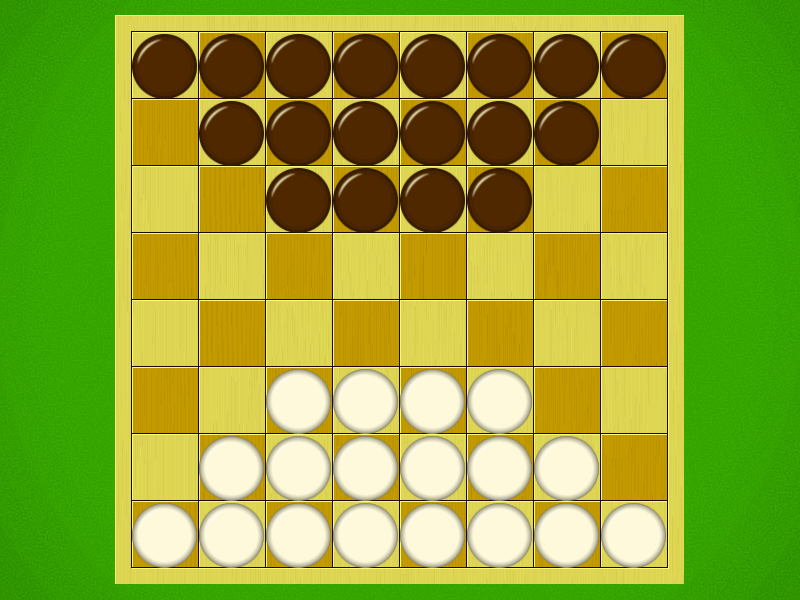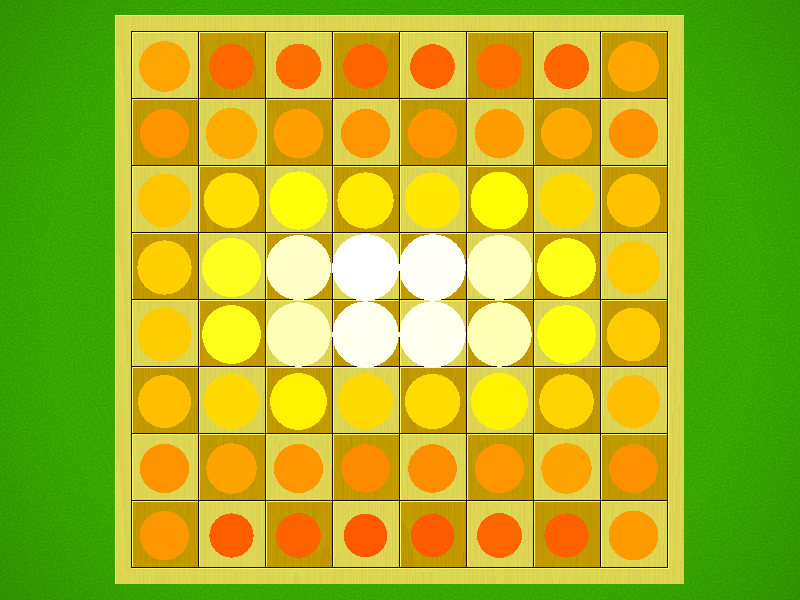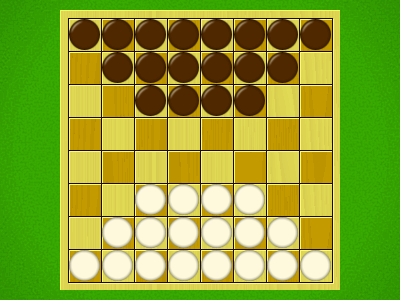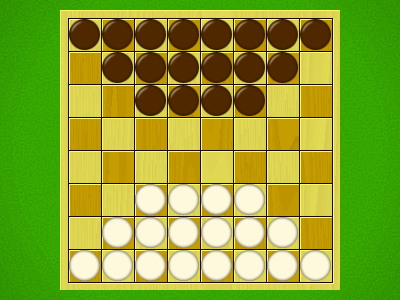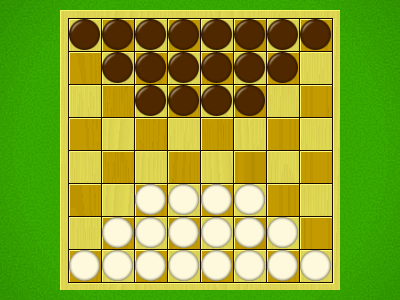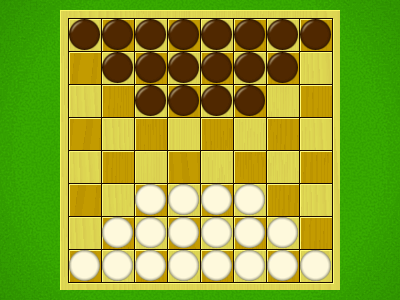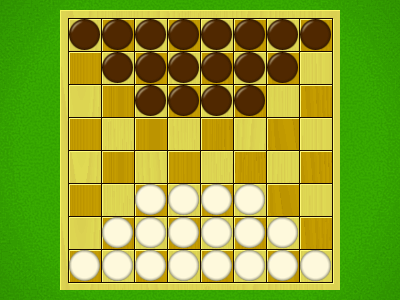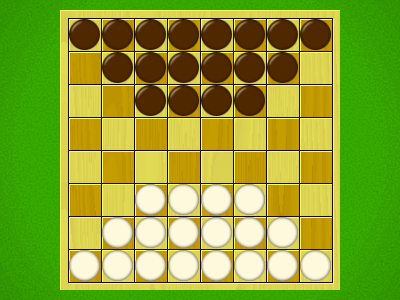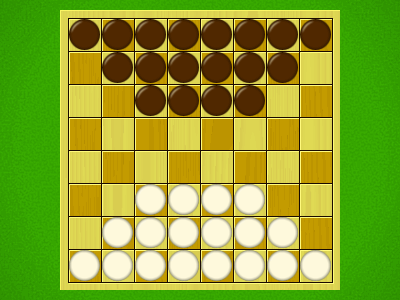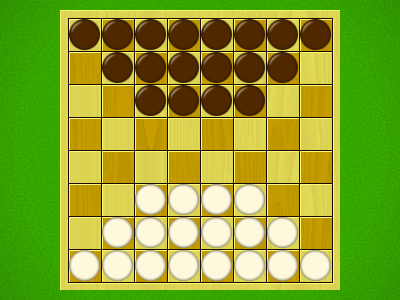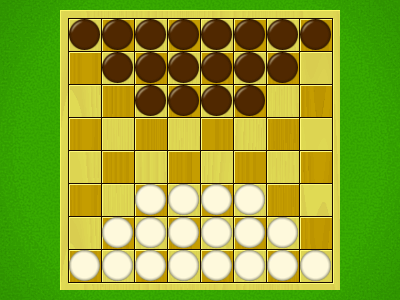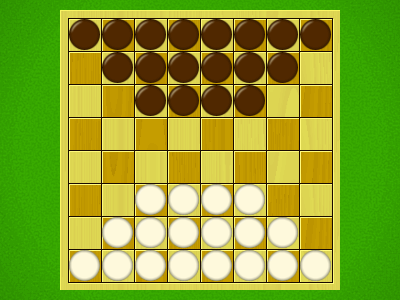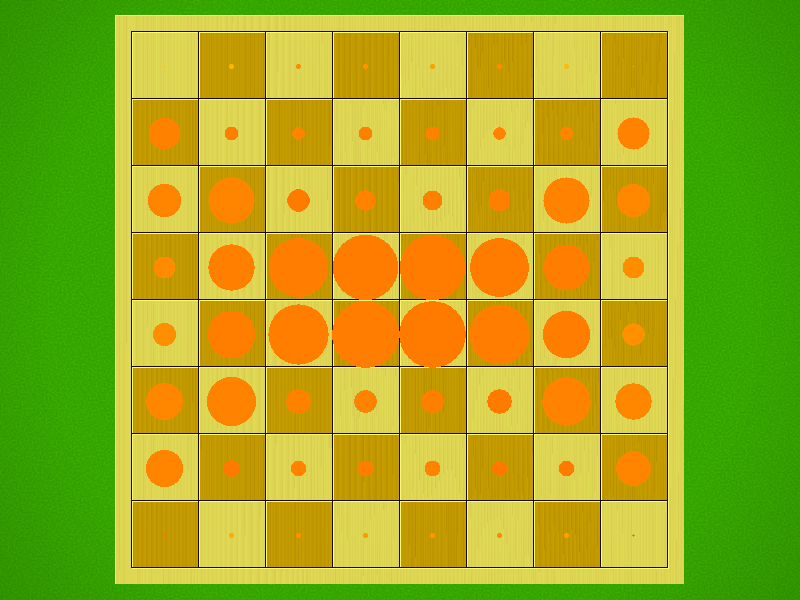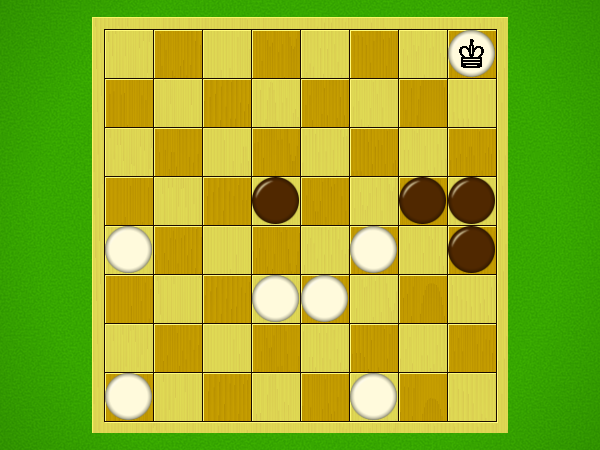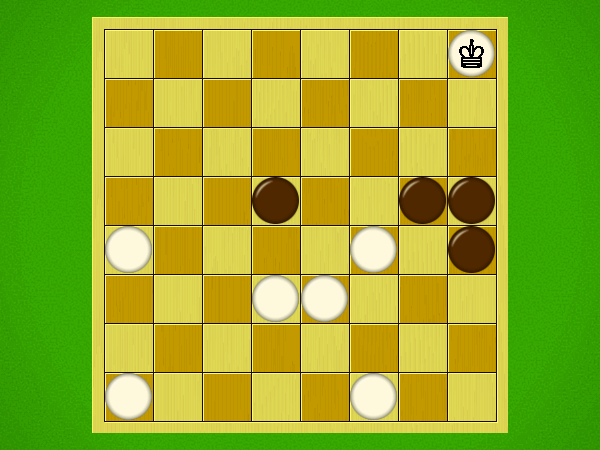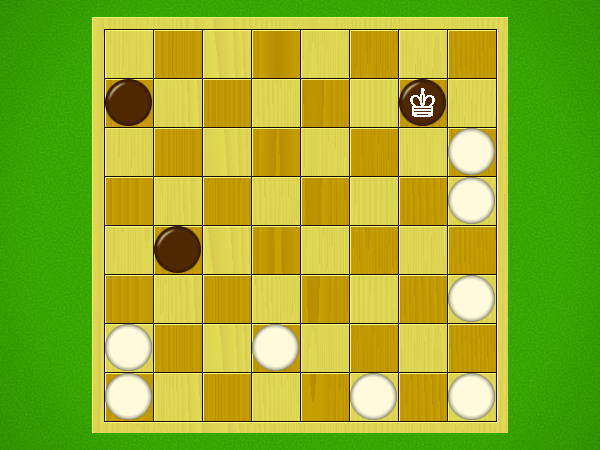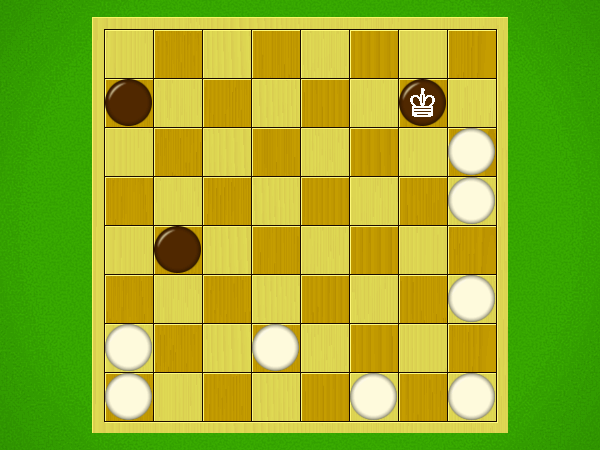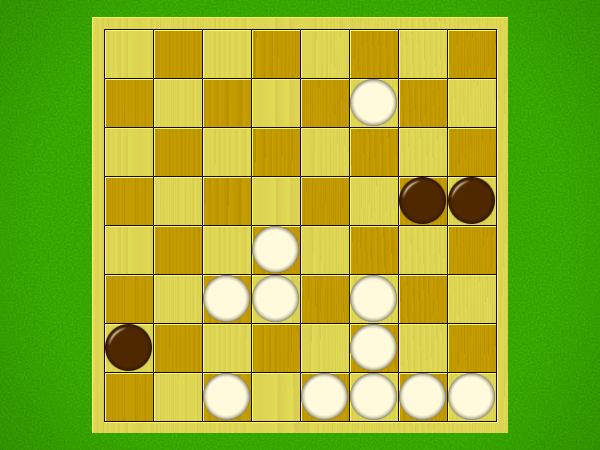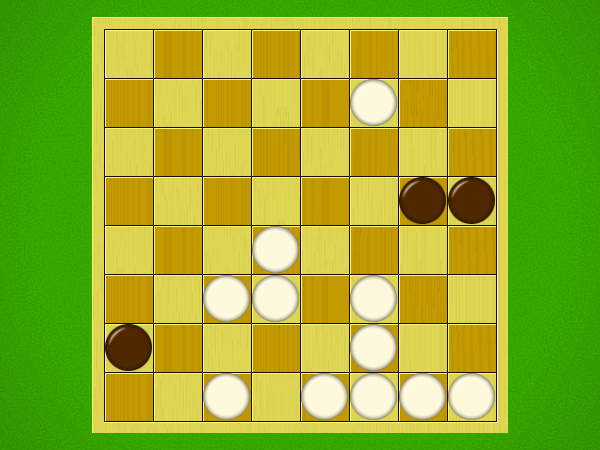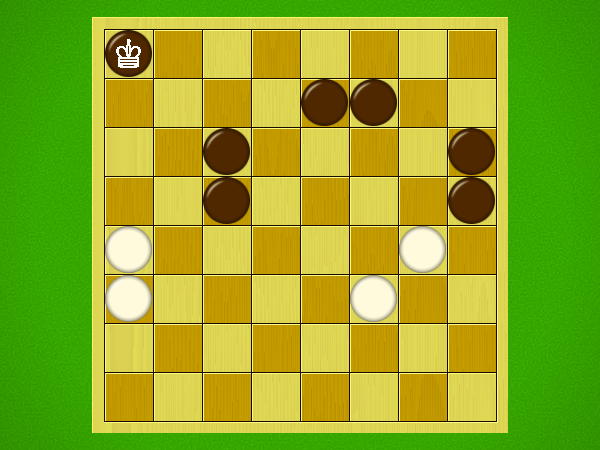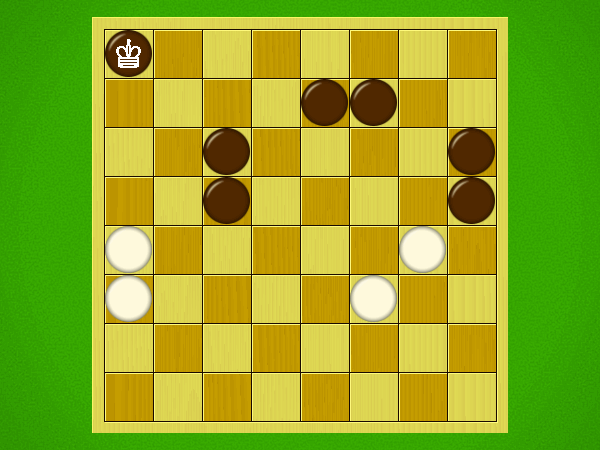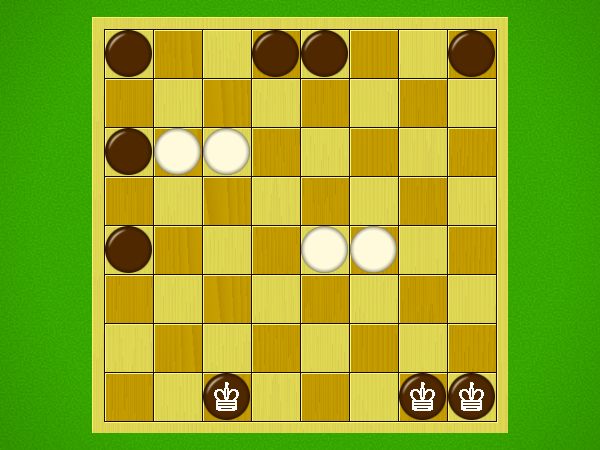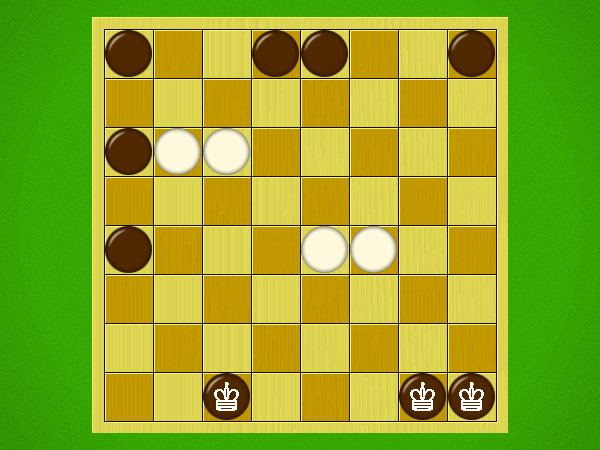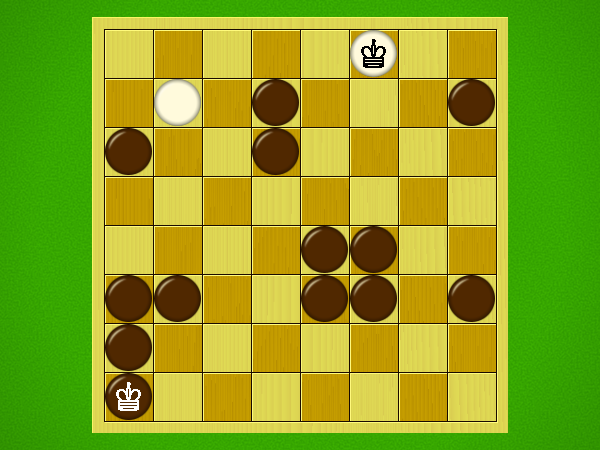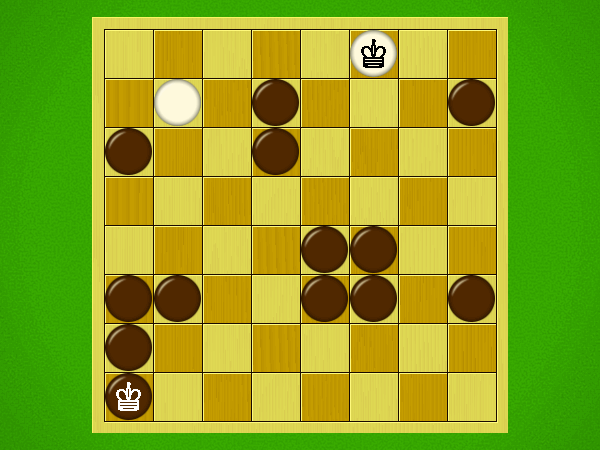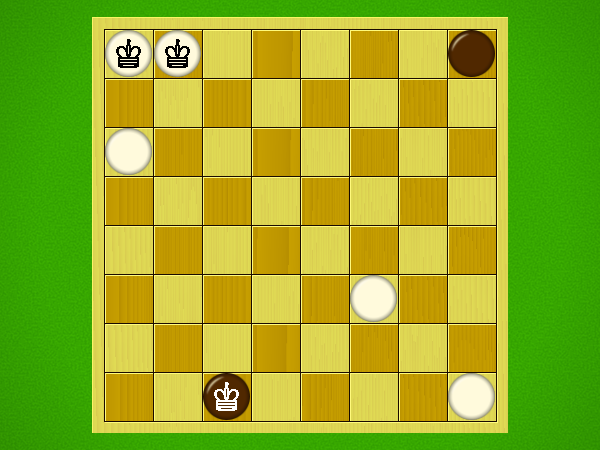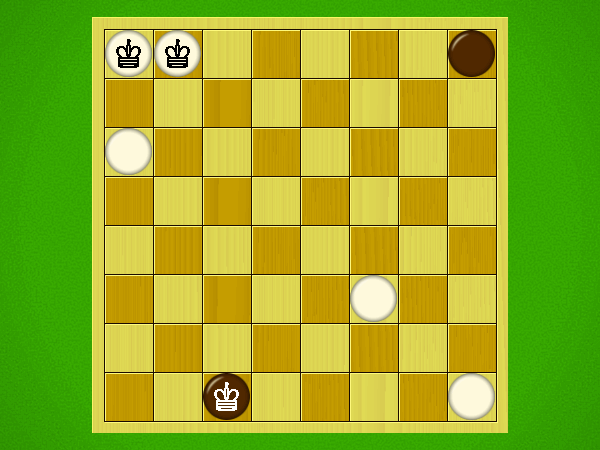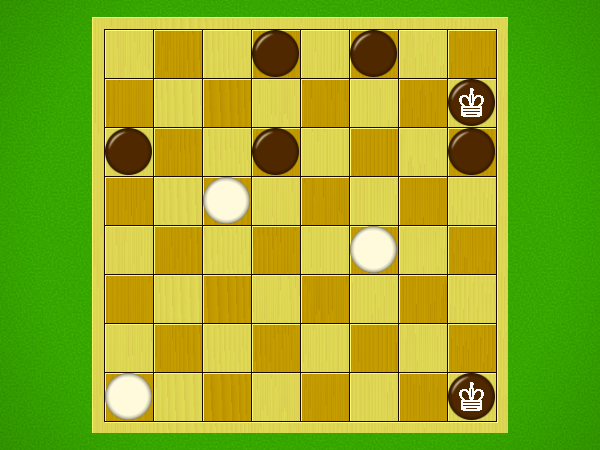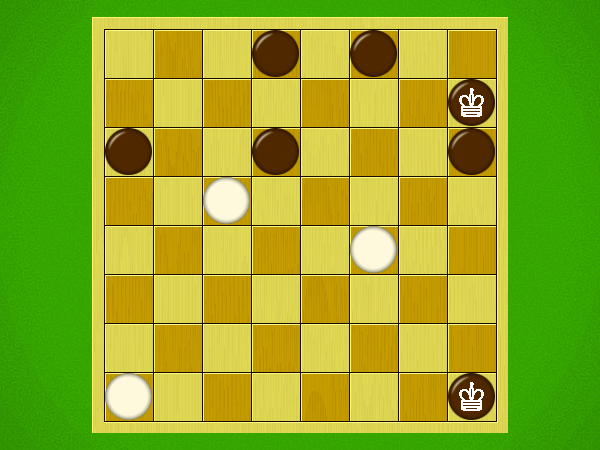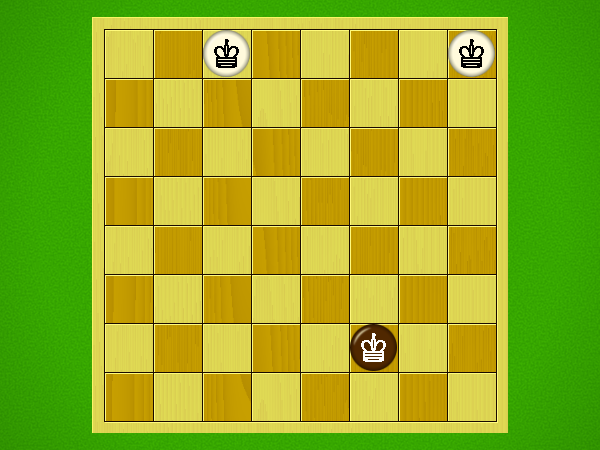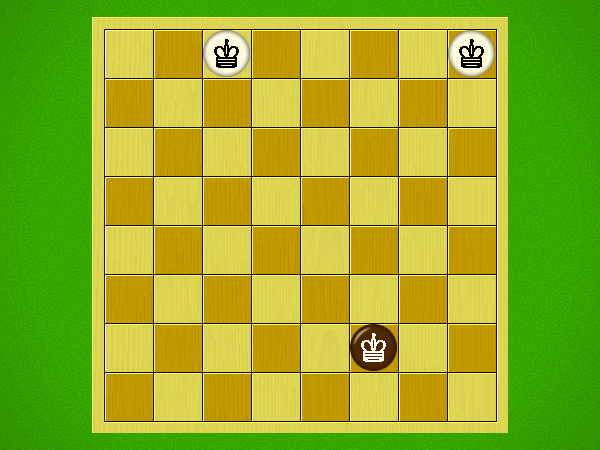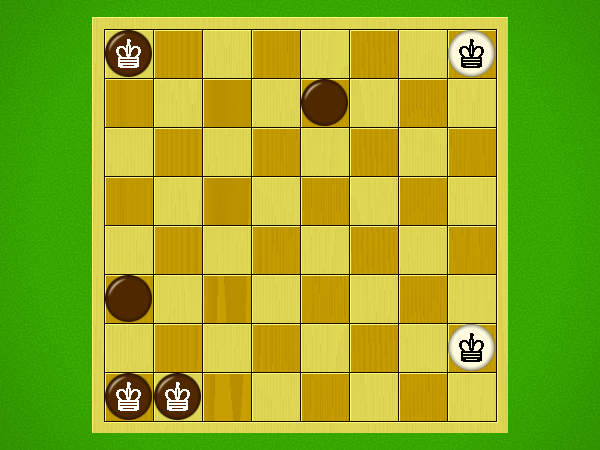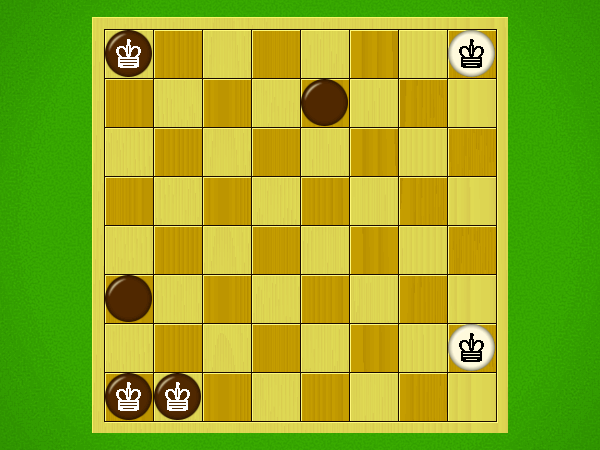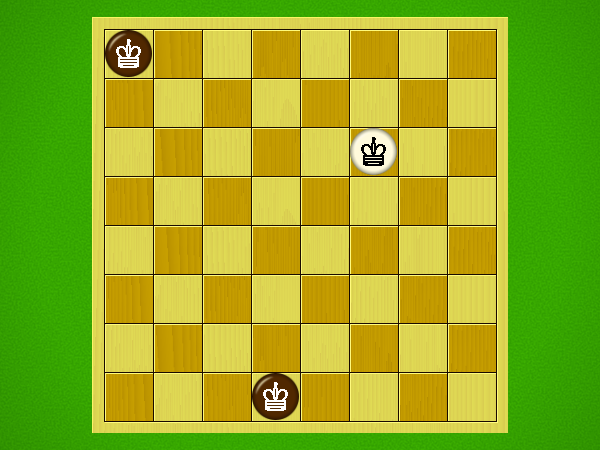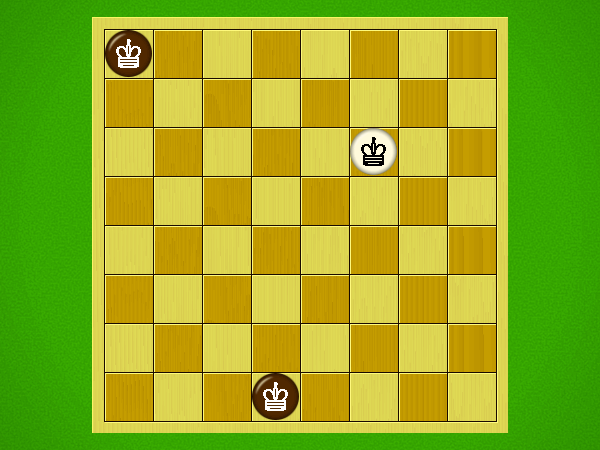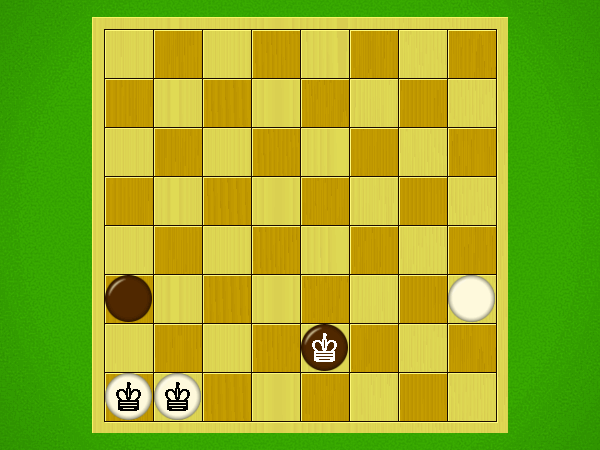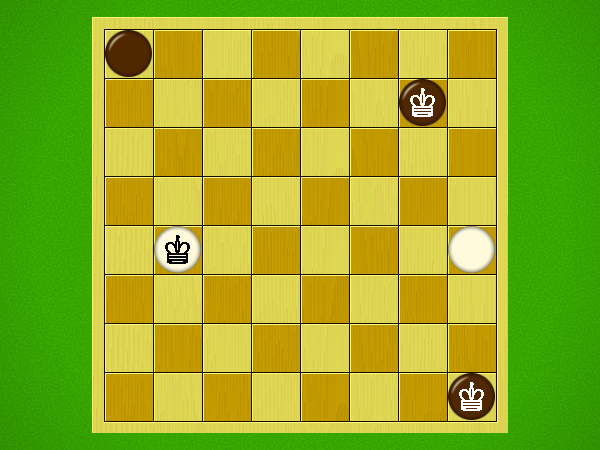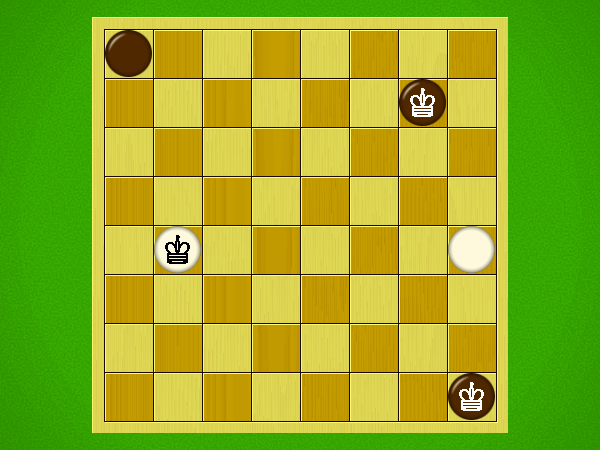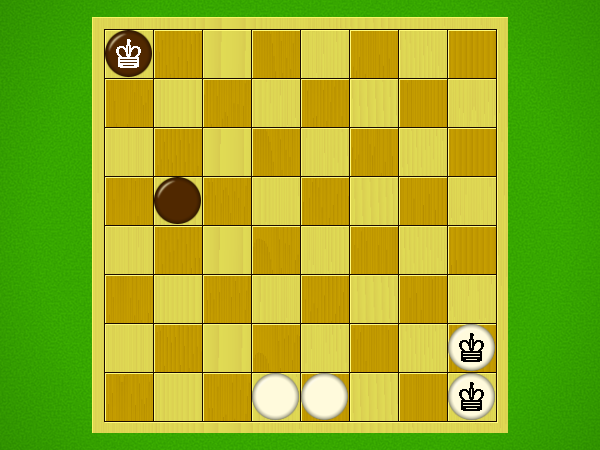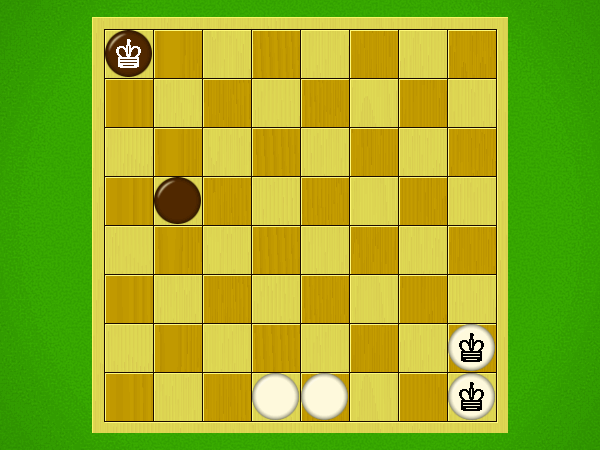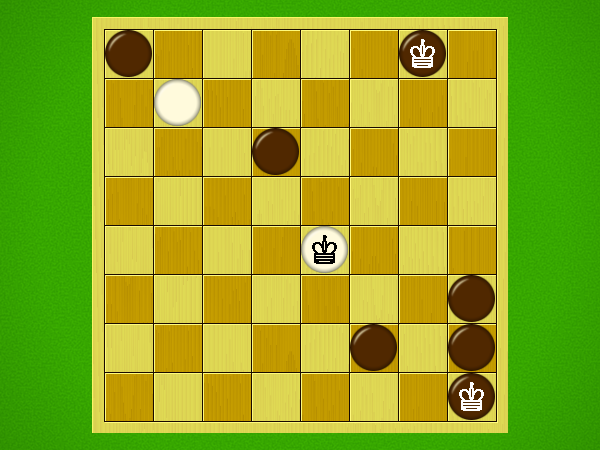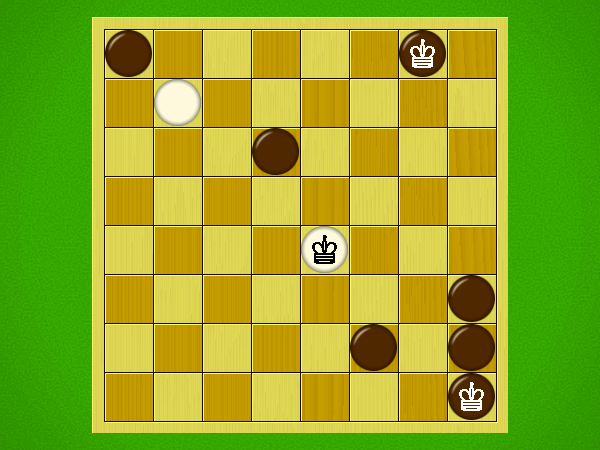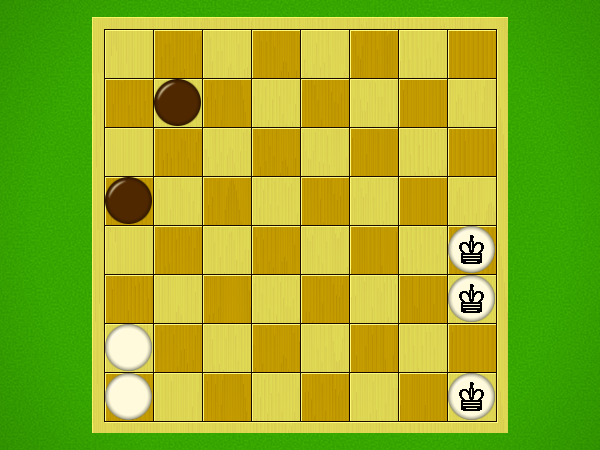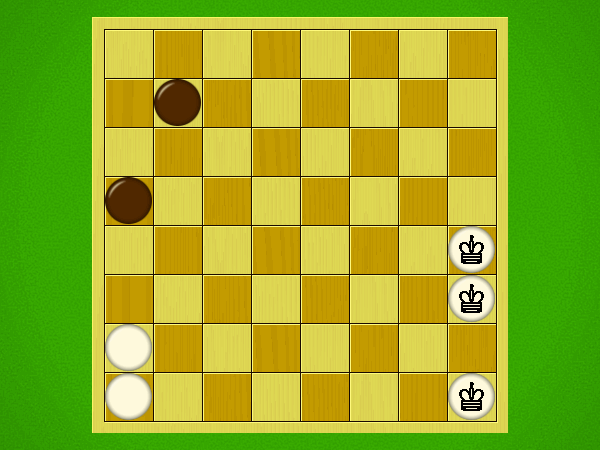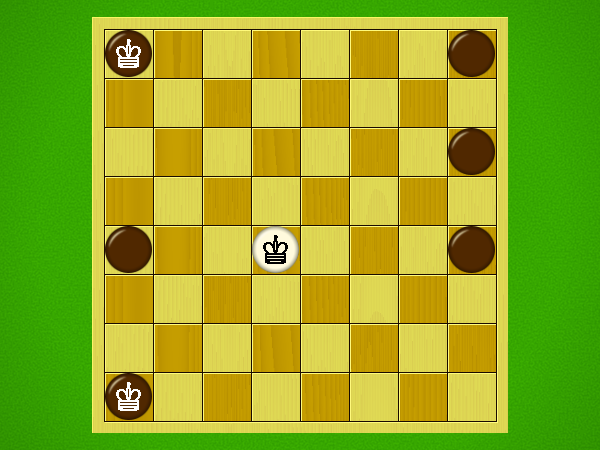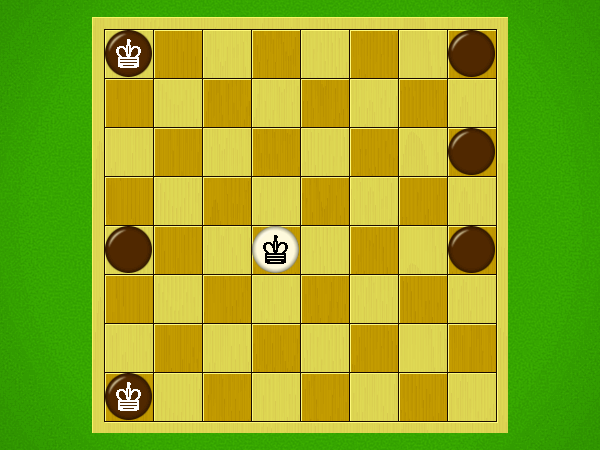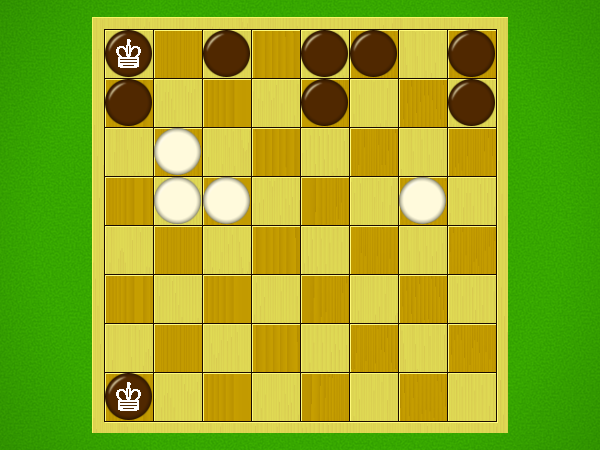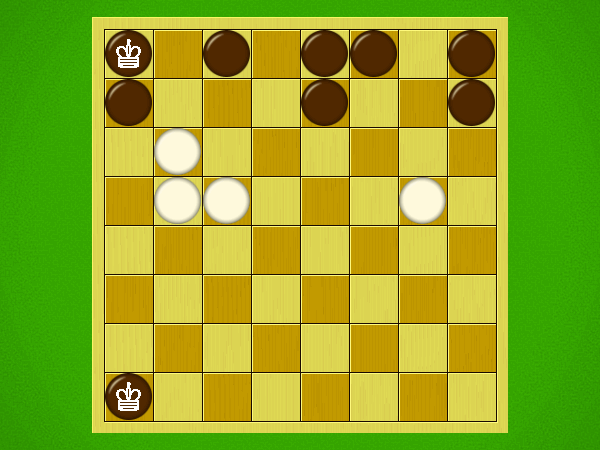| User | Rating | Comment |
|---|
| fxjohn | N/A | Checkers board and pieces |
| mrraow | 8 | Fast and brutal checkers variant. I like it :) |
| fogus | 7.3 | |
| Observer9 | 8 | |
| dooz | 5 | |
| Nap16 | 5 | Free Print & Play Checkers-like game that uses linear capture. |
| LukeJS | 7 | |
| Malaschitz | 9 | |
| jfshoffst | 7 | |
| rayzg | 5 | I'm not a big fan of checkers or their variants. |
| mynameiswillem | 9 | |
| orangeblood | 10 | Updated to a 10 after 50 plays. This game is what you always wanted checkers to be. Full of strategy and cutthroat tactics. Surprising combos. Multiple ways to win, including slow and defensive or fast and risky. == I've never played a lot of checkers because the American game is not that exciting to me. But I'm delighted to discover how great the game can be with Dameo and International Draughts. And if you doubt the superiority of Dameo over all of them, read “Draughts Dissected” by Christian Freeling for the most thorough comparative discussion of all forms of Draughts you'll ever see: http://mindsports.nl/index.php/draughts-dissected?showall=1&limitstart= |
| anemaat | 7.5 | I know this game through the Dameo Problems and a single play, but as far as I can see, it is definitely superior to [gameid=26920]. Dameo has a very narrow draw margin, which is seen as an advantage. I am more comfortable with the wider draw margin in [gameid=26952], where you can fight for a draw once you fall behind. This checkersvariant certainly has depth. Keep the corners occupied, so that you can easily trap an enemy king. |
| elhnad | N/A | Iggamecenter or littlegolem |
| simpledeep | 7 | |
| schwarzspecht | 8 | |
| mjf71 | N/A | 2 40m |
| PSchulman | 7 | |
| ed_in_play | N/A | use Othello board and pieces to play |
| RichardIngram | 9 | |
| tckoppang | 8 | The designer created Dameo with the imperfections of International Checkers in mind. These imperfections include, especially problems with the endgame that lead to an above-average number of draws among expert players. Wow, does that not apply to me! I play and enjoy all number of checkers variants including regular old American Checkers/English Draughts, International Checkers, and a bunch of lesser-known "weird" variations. They all hold something for me as a casual player who grew up playing with his grandfather. That said, how can I resist a designer version of a folk game I love? Answer: I can't. Dameo feels like checkers, but only once you start playing. To look at the board, or to hear the rules is to think of Dameo as an alien game. Even if you think of it as a blend of International and Turkish Checkers, there are concepts that would seem to violate the spirt of both. For example, you can move an entire line of men (think Abalone or Epamimondas), not just one at a time. You must move forward, as in any checkers variant, but you can move both diagonally and straight ahead. Once kinged, you can move in any direction, as a queen in Chess. The board is set up as a stunted pyramid instead of a clean rectangle of men. There are reasons for all of these rules, and they are good reasons, but you there's no use telling a checkers player that it all makes sense because on first blush it feels different. Dont' let any of these difference prevent you from playing the game, however, even if you're a die hard traditionalist, because Dameo is wonderful. It plays quickly and manufactures excitement and turnarounds like it was born to do it. The game feels like a chess match in that there is both breadth and depth to each move. The funny setup and the increase in checker movement options worth to create a board state that is wide open from the start, and that makes for lines of attack that are sometimes unintuitive (or surprising), especially when you first start familiarizing yourself with the game (and more so if you're coming from a checkers background). The bottom line is that the game has a lot to offer, and not just for checkers enthusiasts. If you're interested in abstract games at all, this one is worth checking out. My wife and I were recently on a camping trip, and we both played game after game at the picnic table because we were having so much fun, and because we both wanted to test out new strategies. That the game can manage both fun and strategy with only the basic framework of checkers (as weird as it may look at first) is a testament to Dameo's strengths. |
| The Player of Games | 9 | Excellent checkers variant! Usually I am not that much into [thing=2083] [/thing]. However, this agressive variant with fast pieces development, orthogonal captures and a very powerful flying King is right up my alley. Needs 18 checkers pieces of each color and a standard 8x8 chess board. I can play this game using my standard Chess board and my [thing=197405] [/thing] pieces. However, I have now sets (seven different colors, 50 of each) of 1.75'' Backgammon pieces, which perfectly fit my Chess board as well as my two 10x10 [thing=70802] [/thing] boards. Thus, I have nice playing materials allowing me to play most checkers variants including Dameo. |
| Colonnello Vincent | 5 | |
| seneca29 | N/A | Homemade |
| unic | 8 | |
| gmcnish | N/A | Doesnt immediayely appeal, but have read great things about it. Chessboard, 2x16 bits |
| T0afer | 10 | Dameo is absolutely outstanding and outclasses all other draughts variants including International Checkers, Turkish Checkers, and the various solutions that have been proposed to fix the draw issue of high level play. It absolutely deserves a 10 for its depth and variety in gameplay that you just don't see in any other variant. I can confidently say that I wouldn't be sad at all if dameo replaced the other checkers games. |
| bdeink | N/A | Dameo is a lot of fun, but doesn't get played that much. |
| JimmyMike | N/A | Adapted my 9x9 Go board to do the trick. |
| rushhowe | 8 | |
| AbstractStrategy | 8 | |
| cdunc123 | 9.5 | I've only played eight or so games of this, but I enjoyed it immensely. The extra movement and more powerful kings are a great improvement on the checkers I know from my childhood! Data from thousands of games on BrainKing.com suggests that Dameo is remarkably balanced in terms of first-player / second-player advantage. It also has a very low draw rate. (Though I suspect that draw rates among beginners are higher than the draw rates on BrainKing, since beginners typically won't know [url=https://boardgamegeek.com/thread/1772778/dameo-kings-vs-king-question]the method for beating one king with two kings.[/url]) It also has lots of drama for such a simple rule set (dramatic come-from-far-behind wins are possible). If there is an justice in game appreciation, humans will still be playing this hundreds of years from now. |
| CDRodeffer | 7 | The description above is not quite accurate. Dameo is a high-powered Turkish Checkers type game that also adds linear movement (from Bob Abbott's Epaminondas / Crossings). I really like this one, and it can be played on a Chess board with either Poker chips or a double or Continental Checkers set. Its only flaw is that the end game is a draw if it's one-on-one kings, but that's true for almost all Checkers games. |
| sestos | 7 | |
| ceenan | 8 | |
| russ | 7 | |
| longhunter | N/A | Purchased 2 sets of checkers to play Lines of Action and Dameo on my chess board. |
| javinoa | N/A | DIY |
| Zapawa | 8 | Probably the most beautiful Draughts variant I've ever seen. It took me some time to dissect it and see what little design element serves what purpose in the gameplay, but as soon as I understood it, I fell in love. The game suffers from a "dull opening" problem, but probably less so than Dameo. And, to be fair, having to play a lot of moves before serious exchanges start has its upsides too -- you get more control over your position. In general, control is a central theme of Dameo, as varied possibilities of movement feel liberating when compared to other Draughts variant. I seriously doubt the game will ever meet its stated goal of replacing International Draughts -- but the world would be a better place if it did. |
| Alex8705 | 7 | |
| D Beau | 10 | I like it! All the multi-capturing craziness of Turkish Checkers, but with fewer draws and a lower first player advantage. In fact, of all the Checkers variants playable at Brainking.com, Dameo has the lowest player imbalance (based on the 2000+ plays logged at said site). The only bummer is that it requires more checkers than a standard Checkers set contains. Not that having less would make it a better game, but it would certainly be more accessible (a la Lines of Action). Dameo is well worth the trouble of finding some extra checkers though. --- Okay, I am seriously loving this game. It's so dynamic, that even when you're way below on material and things are looking grim, you still have a chance to turn the game around if you can sneak a pawn through for promotion. This is pretty much everything I enjoy in a abstract; elegance, drama, excitement, bloodshed, and a stunning capacity for clever tactics. --- Okay, I've played Dameo enough now to feel comfortable giving it a 10. In fact, anything lower would feel absurd, as it has slowly worked it's tendrils into my brain and become one of my favorite games. No flaws have surfaced, every game is interesting and enjoyable, and there's a huge amount of room for creativity (unlike most forms of checkers, which feel very rigid). The only disappointment is that, though opponents are readily available online, there doesn't seem to be much of a devoted following. It is deeply frustrating to have an enthusiasm which cannot be effectively shared with others. |
| Alteffor | 8 | Best draughts variant. Tons of interesting play here. The row movement, the flying kings, and the disconnect between the forward movement and orthogonal capture rules are downright fascinating. This game is worth exploring. |
| Zickzack | 8 | As Croda, a serious and informed approach to improve on Draughts. Less crammed than it, too. Pieces have additional range of movement leading to combinations spanning the whole board. |
| BozoDel | 10 | I don't have much experience with checkers, just a few matches of [geekurl=/boardgame/157416/brazilian-checkers]Brazilian[/geekurl] under my belt. I think this is pretty good. The opening in Brazilian Checkers was very opaque to me, it seemed random, even. I guess that a lot of traditional variants rely on opening memorization. But in Dameo it's easy to make sense of things from the very beginning. At first I wasn't very excited about the addition of diagonal movement to an orthogonal game, nor about linear movement, it all seemed very uncheckerlike (I don't know how Mr. Freeling thinks this is natural, while considering Killer Draughts' solution "tacked-on"). But after the first match it all felt very natural. I still want to try [geekurl=/boardgame/45764/harzdame]Harzdame[/geekurl], though, seems like a more elegant solution. -------- I too, after some dozens of plays, am compelled to rate this a 10! It's so... yummy... |
| milomilo122 | 9 | Superb. This is checkers variant, and I dislike checkers, but ADORE Dameo. It's a beautiful illustration of what you can do with modern design principles. This is the final of Christian Freeling's "major" games I've explored, due to my aforementioned apathy towards checkers, but after a year of playing it with focus, it's on my Mt. Rushmore of games. It feels free and creative in a way most checkers games don't to me, as well as balanced and decisive. The scope for combinations is breathtaking. I love the kinds of comebacks that are possible through them. It also has a warmth and approachability many combinatorial games lack. On the whole, it's illustrative of the great (and mostly unknown) progress made in combinatorial game design in the modern era. There's a great beauty in these developments I wish I could help more people discover. If there are any problems with it, they only show themselves at a level of play FAR above anything I've experienced. My open questions about high-level play are a) will the edges become too important?; b) what are the chances of creating a full "lock up", where the game ends when neither player can move (if it would happen, it would happen in the opening, which for me would be anticlimactic)?; and c) will it become too much a battle of breakthrough, since Dameo Kings are *crazy* powerful? |
| tkvaran | 9 | |
| Talisinbear | 8 | This one really grows on you. Excellent |
| bellaatriks | 9 | |
| dralius | 6 | |
| Skaboy | 7 | |
| IronChefZod | 7 | |
| andyofsweden | 10 | I consider Dameo to be the best game of the draughts family and one of the greatest modern abstracts. Game experience is simply sublime. |
| Jugular | 5 | |
| games56 | 9 | |
| arcticnights | N/A | checkers board |
| trawlerman | 8 | |
| FiveStars | 6.9 | nice crossover between Epaminondas and Checkers |
| pezpimp | 4 | Based on one play: A Checkers variant where a line of your pieces can move forward or diagonally forward together one following the other in a row. Kings are seriously overpowered as they can capture while jumping over empty spaces continually thus taking out large parts of the board. Can't say I enjoy the basic mechanics of Checkers and this variant makes it a little more chaotic and an error can really cost you. |
